Items
Tag
media
-
 "The Whitechapel Murder: The Inquest and Verdict" This article clipping from "The Standard" reports the events of the inquest into Ripper victim Mary Jane Kelly's murder in November 1888. It recounts updates on the London Metropolitan Police's progress in the case, as well as testimony from the coroner and witnesses (many of whom were neighbors of Kelly's at Miller's Court). Testimony from Ripper suspect Joseph Barnett was included in this inquest as well, helping to bring about a final verdict that the body at Miller's Court did in fact belong to Kelly.
"The Whitechapel Murder: The Inquest and Verdict" This article clipping from "The Standard" reports the events of the inquest into Ripper victim Mary Jane Kelly's murder in November 1888. It recounts updates on the London Metropolitan Police's progress in the case, as well as testimony from the coroner and witnesses (many of whom were neighbors of Kelly's at Miller's Court). Testimony from Ripper suspect Joseph Barnett was included in this inquest as well, helping to bring about a final verdict that the body at Miller's Court did in fact belong to Kelly. -
 "The Whitechapel Murder: The Inquest; Further Details" This article clipping from "The Reading Observer" details the inquest into the murder and crime scene of Mary Jane Kelly, which presented evidence for Joseph Barnett's suspected involvement in the murder. The article also presents evidence from other witnesses in the inquest, many of whom were acquaintances of the victim. Barnett lived with Kelly until shortly before her death and has been considered a suspect or person of interest in the case since November 1888.
"The Whitechapel Murder: The Inquest; Further Details" This article clipping from "The Reading Observer" details the inquest into the murder and crime scene of Mary Jane Kelly, which presented evidence for Joseph Barnett's suspected involvement in the murder. The article also presents evidence from other witnesses in the inquest, many of whom were acquaintances of the victim. Barnett lived with Kelly until shortly before her death and has been considered a suspect or person of interest in the case since November 1888. -
 "Bodies of Elizabeth Stride and Catherine Eddowes (Jack the Ripper victims) are discovered, Oct 1888" This article clipping from "The (London) Times", a conservative newspaper, reports on the "double murder" of Elizabeth Stride and Catherine Eddowes in a much more serious tone than satirical newspapers of the time. It details evidence found at the scenes of both crimes, as well as some speculation into the killer's intent and the lives of the victims. The police are credited for narrowly missing the murderer the night before, yet are also accused of failing to follow vital clues in the case that would allow them to catch the Ripper.
"Bodies of Elizabeth Stride and Catherine Eddowes (Jack the Ripper victims) are discovered, Oct 1888" This article clipping from "The (London) Times", a conservative newspaper, reports on the "double murder" of Elizabeth Stride and Catherine Eddowes in a much more serious tone than satirical newspapers of the time. It details evidence found at the scenes of both crimes, as well as some speculation into the killer's intent and the lives of the victims. The police are credited for narrowly missing the murderer the night before, yet are also accused of failing to follow vital clues in the case that would allow them to catch the Ripper. -
 "The East-End Murders" This clipping from "The (London) Times", a conservative newspaper, reports on developments in the investigation of Catherine Eddowes' murder. It mentions specifically new evidence collected by the London Metropolitan Police from witnesses and the coroner's report that will be presented at inquest.
"The East-End Murders" This clipping from "The (London) Times", a conservative newspaper, reports on developments in the investigation of Catherine Eddowes' murder. It mentions specifically new evidence collected by the London Metropolitan Police from witnesses and the coroner's report that will be presented at inquest. -
 "East End Outrages: Another Brutal Murder. Mutilation of the Victim, Panic in Whitechapel, Special Details" This article clipping from "The Observer", a liberal London newspaper, reports the murder of the second of the five canonical Ripper victims, Annie Chapman. It shares many details of the crime scene, the timeline of the murder and subsequent investigation, and interviews with some who knew Chapman.
"East End Outrages: Another Brutal Murder. Mutilation of the Victim, Panic in Whitechapel, Special Details" This article clipping from "The Observer", a liberal London newspaper, reports the murder of the second of the five canonical Ripper victims, Annie Chapman. It shares many details of the crime scene, the timeline of the murder and subsequent investigation, and interviews with some who knew Chapman. -
 "The Seventh Murder in Whitechapel" This article clipping from "The Pall Mall Gazette", a radical British newspaper, describes the life, murder, and investigation of Mary Jane Kelly (the "last victim" of the Ripper's "canonical five"). The article both reports the horrific details of her crime scene and attempts to illustrate the harsh quality of life experienced by Kelly and others around her in the Whitechapel district of London. It ends with some consideration of possible trends in the murderer's behavior, as determined by comparisons between Kelly's killing and the other murders previously attributed to the Ripper.
"The Seventh Murder in Whitechapel" This article clipping from "The Pall Mall Gazette", a radical British newspaper, describes the life, murder, and investigation of Mary Jane Kelly (the "last victim" of the Ripper's "canonical five"). The article both reports the horrific details of her crime scene and attempts to illustrate the harsh quality of life experienced by Kelly and others around her in the Whitechapel district of London. It ends with some consideration of possible trends in the murderer's behavior, as determined by comparisons between Kelly's killing and the other murders previously attributed to the Ripper. -
 "Sir Charles Warren's Resignation" An article clipping from "The Essex County Standard", a conservative Tory newspaper, which hints that the resignation of London Metropolitan Police (Scotland Yard) Chief Commissioner Warren in November 1888 could have been related to the unsolved case of Whitechapel murders attributed to Jack the Ripper.
"Sir Charles Warren's Resignation" An article clipping from "The Essex County Standard", a conservative Tory newspaper, which hints that the resignation of London Metropolitan Police (Scotland Yard) Chief Commissioner Warren in November 1888 could have been related to the unsolved case of Whitechapel murders attributed to Jack the Ripper. -
 "From Hell" letter A letter sent to George Lusk, the head of Whitechapel's Mile End Vigilance Committee, on October 16, 1888. The message was supposedly accompanied by half of a kidney (purportedly from Catherine Eddowes), which was later thought to be a prank.
"From Hell" letter A letter sent to George Lusk, the head of Whitechapel's Mile End Vigilance Committee, on October 16, 1888. The message was supposedly accompanied by half of a kidney (purportedly from Catherine Eddowes), which was later thought to be a prank. -
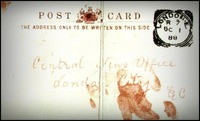 "Saucy Jacky" postcard A postcard, sent to the Central News Agency on October 1, 1888 and signed "Jack the Ripper, which takes credit for the murders of Elizabeth Stride and Catherine Eddowes the previous night.
"Saucy Jacky" postcard A postcard, sent to the Central News Agency on October 1, 1888 and signed "Jack the Ripper, which takes credit for the murders of Elizabeth Stride and Catherine Eddowes the previous night. -
 "Dear Boss" letter A letter, written in red ink, mailed to the Central News Agency between September 25-27, 1888, and then sent to Scotland Yard (London Metropolitan Police), claims responsibility for the murder of Annie Chapman and includes details from the crime scene that were not known by the public. The content of the message and threats of future victims implied that the author of the note could be the real killer. The famous pseudonym "Jack the Ripper" comes from the signature line on this letter.
"Dear Boss" letter A letter, written in red ink, mailed to the Central News Agency between September 25-27, 1888, and then sent to Scotland Yard (London Metropolitan Police), claims responsibility for the murder of Annie Chapman and includes details from the crime scene that were not known by the public. The content of the message and threats of future victims implied that the author of the note could be the real killer. The famous pseudonym "Jack the Ripper" comes from the signature line on this letter. -
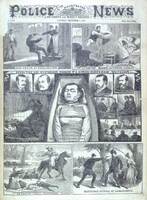 "Murder at Buck's Row" The front page of one of the earliest British tabloids, illustrating the murder of Ripper victim Mary Ann Nichols on Buck's Row in the Whitechapel district of London.
"Murder at Buck's Row" The front page of one of the earliest British tabloids, illustrating the murder of Ripper victim Mary Ann Nichols on Buck's Row in the Whitechapel district of London. -
 "The Nemesis of Neglect" An illustration from the satirical magazine "Punch" that connects the crime of London's slums to neglect and makes vague references to the Jack the Ripper murders in the East End's Whitechapel district. It also has a caption reading, "There floats a phantom on the slum’s foul air Shaping, to eyes which have the gift of seeing, Into the spectre of that loathly lair. Face it – for vain is fleeing. Red-handed, ruthless, furtive, un-erect, 'Tis murderous crime, the nemesis of neglect."
"The Nemesis of Neglect" An illustration from the satirical magazine "Punch" that connects the crime of London's slums to neglect and makes vague references to the Jack the Ripper murders in the East End's Whitechapel district. It also has a caption reading, "There floats a phantom on the slum’s foul air Shaping, to eyes which have the gift of seeing, Into the spectre of that loathly lair. Face it – for vain is fleeing. Red-handed, ruthless, furtive, un-erect, 'Tis murderous crime, the nemesis of neglect." -
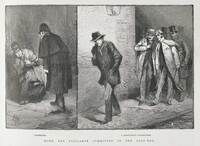 'With the Vigilance Committee in the East-End' An illustration from 'The Illustrated Police News' that satirizes the investigation efforts of the police (harassing the homeless in the East End of London) with the investigations of an East End militia, the Whitechapel Vigilance Committee (trailing a suspect assumed to be Jack the Ripper).
'With the Vigilance Committee in the East-End' An illustration from 'The Illustrated Police News' that satirizes the investigation efforts of the police (harassing the homeless in the East End of London) with the investigations of an East End militia, the Whitechapel Vigilance Committee (trailing a suspect assumed to be Jack the Ripper). -
 "Jack the Ripper. Who is he? What is he? Where is he?" The front page of a weekly London magazine, "Puck", showcasing a cartoon of a man struggling to identify the culprit of the 1888 Whitechapel murders attributed to Jack the Ripper.
"Jack the Ripper. Who is he? What is he? Where is he?" The front page of a weekly London magazine, "Puck", showcasing a cartoon of a man struggling to identify the culprit of the 1888 Whitechapel murders attributed to Jack the Ripper. -
 "Horrible Murder in Whitechapel" An article from "The St. James' Gazette" that reports on the Nichols murder and the mood in Whitechapel at the time.
"Horrible Murder in Whitechapel" An article from "The St. James' Gazette" that reports on the Nichols murder and the mood in Whitechapel at the time. -
 "Mysterious Affair" A newspaper article from "The Nottingham Evening Post" that reports on a Whitechapel murder on August 31st, 1888.
"Mysterious Affair" A newspaper article from "The Nottingham Evening Post" that reports on a Whitechapel murder on August 31st, 1888. -
 "Another Whitechapel Tragedy: Shocking Murder of a Woman. The Crime a Mystery" A newspaper article clipping from "The Eastern Evening News" reporting the murder of the first, official Jack the Ripper victim, Mary Ann "Polly" Nichols.
"Another Whitechapel Tragedy: Shocking Murder of a Woman. The Crime a Mystery" A newspaper article clipping from "The Eastern Evening News" reporting the murder of the first, official Jack the Ripper victim, Mary Ann "Polly" Nichols. -
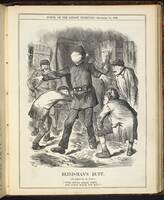 "Blind-Man's Buff" A political cartoon in the British satirical magazine "Punch" that depicts a blindfolded policeman cluelessly surrounded by criminals in London's East End. A caption reads "Blind Mans' Buff. (As played by the Police.) 'Turn round three times, and catch whom you may!'" The cartoon also includes a poem reading "Lurking crime Haunts from of old these dens of darksome slime. There, where well-armed authority fears to tread, Murder and outrage rear audacious head, Unscanned, untracked."
"Blind-Man's Buff" A political cartoon in the British satirical magazine "Punch" that depicts a blindfolded policeman cluelessly surrounded by criminals in London's East End. A caption reads "Blind Mans' Buff. (As played by the Police.) 'Turn round three times, and catch whom you may!'" The cartoon also includes a poem reading "Lurking crime Haunts from of old these dens of darksome slime. There, where well-armed authority fears to tread, Murder and outrage rear audacious head, Unscanned, untracked." -
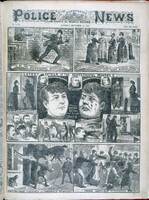 "Latest Details of the Whitechapel Murders" The front page of one of the earliest British tabloids, reporting on the lack of evidence available in the Jack the Ripper case after a few weeks of investigation.
"Latest Details of the Whitechapel Murders" The front page of one of the earliest British tabloids, reporting on the lack of evidence available in the Jack the Ripper case after a few weeks of investigation. -
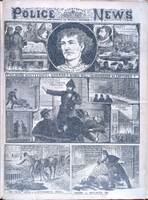 "Two More Whitechapel Horrors: When Will the Murderer Be Captured?" The front page of one of the earliest British tabloids' illustrating the "fifth and six" Whitechapel murders (those of Stride and Eddowes), as well as police investigation of the crime scene.
"Two More Whitechapel Horrors: When Will the Murderer Be Captured?" The front page of one of the earliest British tabloids' illustrating the "fifth and six" Whitechapel murders (those of Stride and Eddowes), as well as police investigation of the crime scene. -
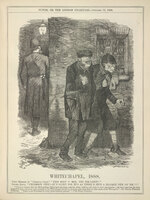 "Whitechapel, 1888" A political cartoon from the satirical magazine "Punch", criticizing the lack of police presence in the Whitechapel district.
"Whitechapel, 1888" A political cartoon from the satirical magazine "Punch", criticizing the lack of police presence in the Whitechapel district. -
 "The Whitechapel mystery" The front page of one of the earliest British tabloids, reporting on the "double event" killings of Catherine Eddowes and Elizabeth Stride.
"The Whitechapel mystery" The front page of one of the earliest British tabloids, reporting on the "double event" killings of Catherine Eddowes and Elizabeth Stride. -
 "The London Murder Scare" The front page of one of the earliest British tabloids, "The Illustrated Police News", reporting on Scotland Yard's lack of progress in solving the Whitechapel murders case.
"The London Murder Scare" The front page of one of the earliest British tabloids, "The Illustrated Police News", reporting on Scotland Yard's lack of progress in solving the Whitechapel murders case. -
 "Portrait Sketches of Supposed Whitechapel Monster and Incidents in the Case" The front page of one of the earliest British tabloids, "The Illustrated Police News", reporting on the killing of Mary Kelly and possible suspects in the case.
"Portrait Sketches of Supposed Whitechapel Monster and Incidents in the Case" The front page of one of the earliest British tabloids, "The Illustrated Police News", reporting on the killing of Mary Kelly and possible suspects in the case. -
 "The Seventh Horrible Murder by the Monster of the East End" The front page of one of the earliest British tabloids, "The Illustrated Police News", reporting on a seventh killing attributed to Jack the Ripper.
"The Seventh Horrible Murder by the Monster of the East End" The front page of one of the earliest British tabloids, "The Illustrated Police News", reporting on a seventh killing attributed to Jack the Ripper.